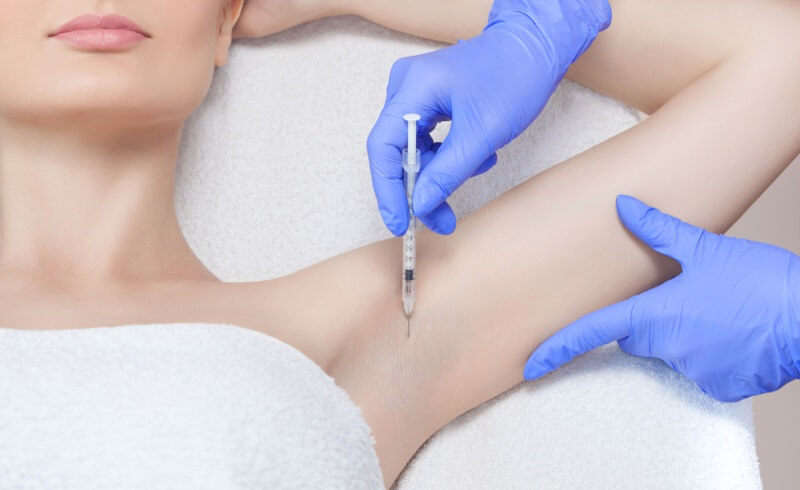The last decade has seen a huge rise in the number of people opting for Botox, but not in the way that you might expect. While Botox is most popular for reducing facial wrinkles and fine lines, many people also use Botox for excessive sweating, particularly in the armpits.
So does Botox in your armpits stop sweating? In short, yes. When injected in the underarm area, Botox has been found to be extremely successful with stopping sweat production in the armpits. This process works through nerve paralysis: the injected Botox paralyzes the nerves which are responsible for activating the sweat glands in the armpit, thus preventing sweat from occurring.
Sweat, the Body, and Botox
When your body temperature rises, your body begins to sweat to cool itself off. The nervous system is responsible for activating this process; when it feels a higher body temperature, it engages with the sweat glands to begin sweat production. However, some people have more active nerves than others, leading to overstimulated sweat glands that produce more sweat than necessary.
How does Botox prevent the armpits from producing sweat?
Botox in the armpits works in the same way that it does on the face, by paralyzing the nerves underneath the skin. After these nerves are paralyzed, they can no longer function for the next several months, preventing them from contracting (as they do in the face, causing wrinkles), or in this case, activating the armpit’s sweat glands.
Botox is a neurotoxin that has been used in cosmetic treatments since the late 80s (Check out our post The Origin of Botox, if you want to learn more). While it was first used to help frown lines disappear, Botox application has since matured and evolved into treating most signs of facial aging, from wrinkles to fine lines.
Doctors continued to experiment with Botox application due to high demand for the product. It was only in 2004 that Botox gained FDA-approval as a hyperhidrosis (excessive sweating) treatment (source).
Since then, doctors have found that Botox can also be injected in other areas of the body to dull overactive sweat production, such as the palms and the feet, however, these are only done as off-label procedures.
Off-Label Botox Procedures for Sweat
When a doctor refers to an off-label usage or procedure, they are referring to a medication or treatment that is used for an application that goes beyond its standard approval. Some patients may be wary of off-label practices, but Botox is still safe beyond the face and underarm area. The only matter is effectiveness.
Where else can Botox be injected to lessen your body sweat? Doctors have successfully treated sweatiness in foreheads, feet, and sweaty palms. However, Botox in these areas generally doesn’t last as long as Botox in the armpits, with forehead sweat reduction lasting an average of five months (source).
Is Botox in the Armpits Right for Me?
3% of the population experiences the excessive sweating condition known as hyperhidrosis.
However, anyone who feels that they sweat more than the average person can opt for a Botox procedure in the underarm area.
But some people might hesitate before considering Botox to solve an issue that might only be mildly irritating. Do you truly sweat more than the average person, or are you simply overthinking it?
How do you know if Botox in the armpits is right for you? According to Dr. Darren Ezer of the Toronto Sweat Clinic, it’s a matter of your quality of life (source). There are some questions you have to ask yourself, including:
- Are you forced to leave social situations because of your underarm sweat or general body sweat?
- Do you find yourself sweating through multiple shirts in a single day?
- Do you sweat through your shirt even without physical exertion?
- Do you find yourself with lower confidence, self-esteem, and productivity issues because of your body sweat?
Whether you have severe hyperhidrosis or just a case of above average sweaty armpits, schedule your appointment for Botox in the armpits at Ethos Spa if you struggle with any of the questions above.

Understanding the Botox Procedure for Sweaty Armpits
After consulting with their chosen doctor and arranging an appointment, there is little to no preparation involved in the days leading up to a patient’s Botox appointment. Here is everything a patient can expect from the Botox procedure:
- Shaving the armpit area is optional, however, a hairless armpit might make the process easier for the dermatologist.
- The patient is given a choice of a numbing cream to help dull the pain of the needle (if it is their first treatment, it’s better to choose to have the numbing cream applied).
- A full bottle of Botox powder is mixed with saline; all of it is necessary for the treatment.
- A small injection map will be drawn in the underarm. While some doctors will opt for a starch iodine test to find the specific sweat glands, most choose not to, as sweat glands are generally in the same area for most people.
- Botox is injected into the armpit, giving the patient a feeling of deep pin pricks. Some patients who are experienced with facial Botox are surprised with the depth of Botox injections in the underarm. This is because the nerves around the armpit are deeper than those in the face, which are more superficial.
- Some patients may experience light pain or bruising after the treatment; aside from this, patients may return to their normal daily activities, work, and exercise immediately after treatment.
- After two weeks, the patient should consult with their doctor about a follow-up appointment. The doctor should check if any final touches are required to complete their treatment.
Here are some common questions regarding Botox after it is injected in the underarm area:
When Will I Experience Results?
The Botox will need some time to fully stifle the nerves in the underarm, but once this has occurred you can expect up to a 90% reduction in your armpit sweat about 2-7 days after the treatment.
For a totally dry underarm experience, wait up to two weeks.
How Long Will It Last?
The effectiveness of Botox varies. Some people may only experience dryness in the underarms for 4 months, while others have reported results lasting up to 14 months. The treatment is recommended roughly every 6 months for continued dryness.
Will It Stop Working?
As long as you have had a Botox armpit treatment in the last few months, then you should expect total dryness in your underarms. That is why this procedure is increasingly popular amongst celebrities, as they need to stay fresh and dry during events and awards shows that demand uncomfortable clothing and bright lights.
Will Botox Stop the Armpit Smell Too?
It’s a common misconception that sweat and smelly armpits are the same thing. Foul-smelling armpits are generally caused by a chemical or bacterial effect, not because of the sweat.
While the smell may slightly lessen as the underarm area becomes less damp, the body odor will still remain. You will still want to use your deodorant for body odor issues.
Can Men Use Botox For Armpit Sweat?
Of course. Botox for body sweat is not exclusive to women; many men are opting for Botox for body sweat issues these days.
Botox: Your Ultimate Body Sweat Solution
Anyone who experiences quality of life issues because of their excessive body sweat can benefit from Botox treatments.
While the injections may not always be covered by insurance, you will only need one or two injections per year to experience radical changes in your day-to-day living.







